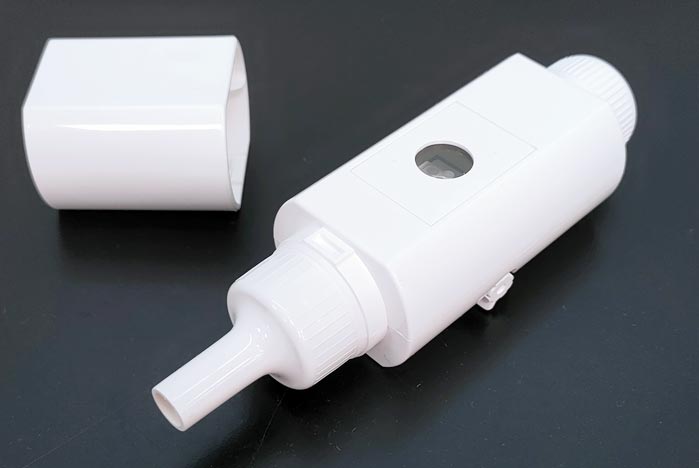Quick COVID breathalyzer could allow mass screening in public places

A SERS-based breathalyzer can distinguish volatile organic compounds in the breath of COVID-positive people in less than 5 minutes.
Credit: Shi Xuan Leong and Yong Xiang Leong, Nanyang Technological University
According to experts, bringing an end to the pandemic will require rapid screening of people attending large gatherings, such as conferences and weddings. Even those who are asymptomatic can still transmit COVID-19 to others, making it important to identify and isolate them until they are no longer contagious. Now, researchers reporting in ACS Nano have developed a prototype “breathalyzer” that can sensitively and accurately diagnose COVID-19, even in asymptomatic individuals, in less than 5 minutes.
Currently, the “gold standard” for COVID-19 testing is a technique called reverse transcription-polymerase chain reaction (RT-PCR), which is slow, requires an uncomfortable nasopharyngeal swab for sample collection and must be performed in a lab. The rapid antigen test is much quicker but has a higher rate of false negatives and positives. Scientists have also developed breathalyzer-type tests for COVID-19, which rely on differences in concentrations of volatile organic compounds exhaled by those infected with the coronavirus, but most require bulky, nonportable instruments for analysis. Xing Yi Ling and colleagues wanted to develop a quick, convenient and accurate breathalyzer test that would be suitable for on-site screening of large numbers of people.
The researchers designed a handheld breathalyzer that contains a chip with three surface-enhanced Raman scattering (SERS) sensors attached to silver nanocubes. When a person exhales into the device for 10 seconds, compounds in their breath chemically interact with the sensors. Then, the researchers load the breathalyzer into a portable Raman spectrometer that characterizes the bound compounds based on changes to the molecular vibrations of the SERS sensors.
The team found that Raman spectra from COVID-positive and -negative people were different in regions responsive to ketones, alcohols and aldehydes, which they used to develop a statistical model for COVID diagnosis. They tested the breathalyzer on 501 people in hospitals and airports in Singapore, who were shown by RT-PCR to be negative (85.2%), positive and symptomatic (8.6%), or positive and asymptomatic (6.2%) for the coronavirus. The method had a 3.8% false-negative and 0.1% false-positive rate, comparable to RT-PCR tests, but it could be completed on-site in less than 5 minutes. The breathalyzer could someday be a new tool to reduce the silent spread of COVID-19 in communities, the researchers say.
The authors acknowledge funding from the National Medical Research Council, Singapore, A*STAR Singapore, the Max Planck Institute-Nanyang Technological University Joint Lab and Nanyang Technological University.
The American Chemical Society (ACS) is a nonprofit organization chartered by the U.S. Congress. ACS’ mission is to advance the broader chemistry enterprise and its practitioners for the benefit of Earth and all its people. The Society is a global leader in promoting excellence in science education and providing access to chemistry-related information and research through its multiple research solutions, peer-reviewed journals, scientific conferences, eBooks and weekly news periodical Chemical & Engineering News. ACS journals are among the most cited, most trusted and most read within the scientific literature; however, ACS itself does not conduct chemical research. As a leader in scientific information solutions, its CAS division partners with global innovators to accelerate breakthroughs by curating, connecting and analyzing the world’s scientific knowledge. ACS’ main offices are in Washington, D.C., and Columbus, Ohio.
To automatically receive news releases from the American Chemical Society, contact newsroom@acs.org.
Journal: ACS Nano
DOI: 10.1021/acsnano.1c09371
Article Title: Noninvasive and Point-of-Care Surface-Enhanced Raman Scattering (SERS)-Based Breathalyzer for Mass Screening of Coronavirus Disease 2019 (COVID-19) under 5 min
Article Publication Date: 18-Jan-2022
Media Contact
Katie Cottingham
American Chemical Society
k_cottingham@acs.org
Office: 301-775-8455
All latest news from the category: Medical Engineering
The development of medical equipment, products and technical procedures is characterized by high research and development costs in a variety of fields related to the study of human medicine.
innovations-report provides informative and stimulating reports and articles on topics ranging from imaging processes, cell and tissue techniques, optical techniques, implants, orthopedic aids, clinical and medical office equipment, dialysis systems and x-ray/radiation monitoring devices to endoscopy, ultrasound, surgical techniques, and dental materials.
Newest articles

Innovative 3D printed scaffolds offer new hope for bone healing
Researchers at the Institute for Bioengineering of Catalonia have developed novel 3D printed PLA-CaP scaffolds that promote blood vessel formation, ensuring better healing and regeneration of bone tissue. Bone is…

The surprising role of gut infection in Alzheimer’s disease
ASU- and Banner Alzheimer’s Institute-led study implicates link between a common virus and the disease, which travels from the gut to the brain and may be a target for antiviral…

Molecular gardening: New enzymes discovered for protein modification pruning
How deubiquitinases USP53 and USP54 cleave long polyubiquitin chains and how the former is linked to liver disease in children. Deubiquitinases (DUBs) are enzymes used by cells to trim protein…



